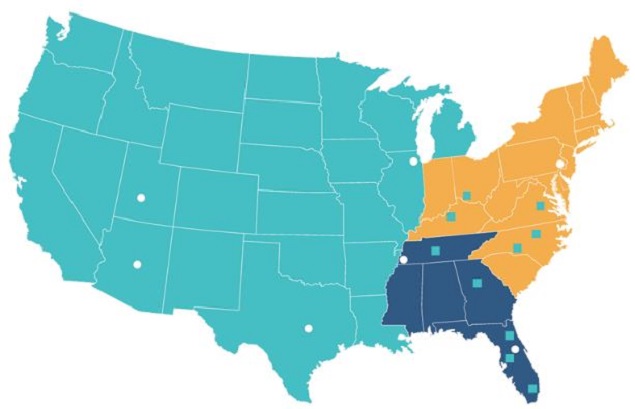Chris Downie spent 16 years in C-suite roles at technology infrastructure services companies, but it's his specific type of experience, rather than its length, that gave Peak 10 ownership confidence that he was the man to take the data center provider to the next level.
Peak 10 has reached a number of milestones -- including both revenue and size of the service portfolio -- making this an ideal time to begin the next stage of strategic growth, David Jones, the company's founder, chairman, and former CEO, whom Downie recently replaced, told Data Center Knowledge in an interview.
Downie, the former CEO of Telx, is not only familiar with peculiarities of running a large data center company owned by private equity, he knows what it's like to run a large data center provider owned specifically by GI Partners, the private equity firm that also owned Telx for a part of his time at Telx's helm.
GI Partners invests in leading companies in fragmented or overlooked markets which it believes can be grown via acquisitions. Downie's charge is "to take Peak 10 into its next phase," while Jones remains active as chairman.
Peak 10 has historically focused on providing a suite of enterprise-quality colocation and managed IT services in secondary markets. The company currently serves over 2,600 mainly small and medium business (SMB) customers.
Read More: Peak 10 and GI Find Winning Formula in Secondary Data Center Markets
Its data center footprint consists of 15 data centers, spread across 10 secondary markets, primarily located in the Southeast and Mid-Atlantic regions of the US.
Source: Peak 10
The squares on the map above represent markets with Peak 10 data centers, while the white dots are business development/customer service offices, which also support strategic partners.
Why Make the Change?
Jones said the decision to bring aboard a new CEO was made about a year ago. After a nine-month search process he and the board concluded that Downie would be an ideal candidate to lead Peak 10 going forward.
Peak 10 has a long history of being owned by private equity firms, and has been solely owned by GI Partners since 2014. Jones said he felt it was crucial that a new CEO understood the challenges of running a company owned by private equity. These can include balancing revenue growth with bottom line performance targets, while nurturing a corporate culture focused on customer service.
Downie's familiarity with structuring exit strategies is also a huge plus. He left Telx after the company was acquired by Digital Realty Trust.
Leveraging a Large Customer Base
Jones pointed out that during the last 12 to 24 months, Peak 10 has been building larger facilities and landing larger accounts -- initiatives which are consistent with positioning the business to go to the next level.
Peak 10 execs said that about 80 percent of its customers would fall into the SMB category. The remaining 20 percent, or over 500 customers, would fall into the larger customer bucket, which consts of companies with 1,000 or more employees. It appears Peak 10 has plenty of logos which could help the company to expand.
While there are non-disclosure agreements with many of these larger customers, a partial list includes: Popeyes Louisiana Kitchen, Tractor Supply, Red Hat, Chiquita, Global Knowledge, and Bealls, Inc.
GI Partners Connection
As we already mentioned, Downie is perhaps uniquely suited to take over the reins of Peak 10, given his recent involvement in a large private equity-backed sale, combined with a history with GI Partners in particular.
Before he became CEO of Telx -- a role he took after his predecessor, Eric Shepcaro, passed away in 2013 -- Downie served as the company's CFO and president, under GI ownership. He continued in that capacity after GI sold Telx to ABRY/Berkshire Partners in September 2011 and left the company as CEO in 2015, after the Digital Realty acquisition.
Read more: Digital Realty Closes $1.9B Telx Acquisition
Notably, GI also sponsored the Digital Realty IPO in 2004. Digital's current CEO, Bill Stein, also has roots which go all the way back to a tenure with GI, having served as Digital's long-time CFO, from the day of the IPO until he was elevated to the CEO role in 2014.
During Investor Day 2015, Stein announced a pivot toward connectivity and a more flexible "Scale" data center design. The Telx acquisition was a cornerstone of this new strategy. Looking at it from the Telx perspective, the transaction led to the successful monetization of Telx for its private equity owners, on Downie's watch.
Building Upon a Solid Foundation
Peak 10 has methodically built its data center footprint over a 17-year timeline, both organically and by acquisition, and most recently, ground-up development. There are very few data center providers that have evolved over such a long period of time under one management team and even fewer that have done it while being owned by three private equity ownership groups.
In an interview with Data Center Knowledge, Downie said he was attracted to the solid foundation and company culture Jones built. He specifically mentioned Peak 10's 400-plus highly trained employees, tenure of the management team, relevant product mix, as well as processes and scale to grow the company to the next level.
Future geographic expansions could be driven by customer needs, strategic alliances, and/or opportunistic M&A transactions. In any event, Jones felt confident that "with Chris on board, we are poised to take the next steps."
According to Downie, it will probably take six to 12 months for those steps to begin to fall into place.
Corrected: A previous version of this article said Peak 10 operated about 30 data centers. A company spokesperson has clarified that 14 of them are "pods" rather than full-fledged data centers, so the total number of data centers has been changed to 15.






